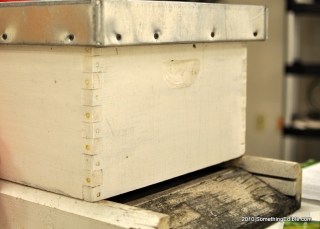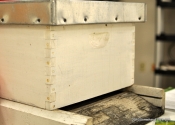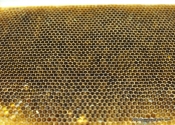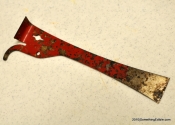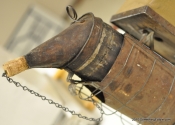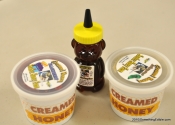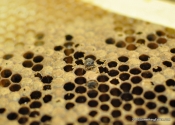Some food, some drink.
Tips on Getting Started in Beekeeping (by proxy).
Abstract: The good folks from which I purchase honey put on a seminar about what it takes to get started in beekeeping. Because I have a background in Entomology (and because I'm nosy), I thought it'd be neat to see what's involved, so I took some notes so I could share the highlights with y'all.
Purpose: I think raw honey is great. It's got a complexity that the
processed stuff can't touch. When you can obtain it locally from
small-batch producers, each jar can be a little different, which
inspires new flavor combinations and new recipes with every season.
When I found out we had local honey producers in here, I was
thrilled. I keep at least 5 pounds of the stuff on-hand and use it
for everything from baked goods, to granola, to mixed drinks (try
making simple syrup with honey instead).
When I
studied Entomology (almost a decade ago; sheesh!), we didn't
spend a lot of time on colony insects, but they've always fascinated
me. That's why when I heard the local
recreation center was hosting a beekeeping seminar, I was one of
the first to sign up.
The seminar was presented by Mr. Greg Swob, one of two brothers
responsible for the Swobee
Honey Farm. Greg's a great guy who takes the time to answer all
your questions. Here are some of the highlights from my notes:
Observation:
- Greg began the talk by going over some basics of bee life history. Worker bees seem to do every stage of their life in about three weeks. Three weeks from egg to adult. Three weeks hanging around the hive; cleaning house and tending to the young. Three weeks foraging for food. Three weeks protecting the hive before they die (think: grumpy old women).
- If you want to keep bees, you really only need a few essentials: Water, plenty of flowering plants, shelter from the wind (real important out here), and a sunny spot to keep the hive (we were told the bees seem to get temperamental with too much shade). Knowing your neighbors is important too. If you're thinking of a residential or urban setup, you'll need to check local ordinances, and it wouldn't be a bad idea to check with the folks next door so as to give them a heads-up in case someone may be seriously allergic. For a rural setup, it's important to know that just about any agricultural pesticide isn't going to agree well at all with a hive. So, even if a hive is put on a pristine tract of CRP land, being down-wind from the kind of folks we used to call “nozzleheads” in Entomology is just bad news for bees.
- Where foraging is concerned, bees are opportunists. Just because workers can travel up to two miles from the hive searching for food, doesn't mean they want to. So pick a spot with plenty of flowering plant potential throughout the warmer weather – and we're not just talking on the ground; look up too! Bees are perfectly happy to forage from those spring maple and elm flowers. Most commercial honey production is done with canola (totally makes sense; have you ever seen the number of flowers a canola plant produces?).
- The costs of getting started with your own hive aren't bad at all. As far as hardware's concerned, you'll need a veil, smoker, and the hive itself, which consists of a box and about 10 frames that the bees will use as a substrate to construct cells on. Around $200 will get you a starter kit which even includes some nifty bonus starter stuff (that you'll probably never use after you get some experience under your belt). Greg also recommends putting the hive on a shipping pallet (plastic if you can find it) to keep the hive off the ground. We're raising bees here, not providing condominiums for small rodents with an all-you-can-eat buffet included.
- As for the livestock, you can start two ways: Buy package bees or buy a nucleus hive (called “nucs” and pronounced like “nukes”). Both of these solutions are about equal in price; less than a c-note in this neck of the woods. Both are usually purchased in late spring to early summer. Package bees consist of three to four pounds of bees (approximately 10,000 bees) with a separately shipped queen. You dump the package & the queen into your box, and hope that everyone gets along. Nucs on the other hand, are working, producing hives that are half the size of a standard hive. To start your very own hive, just swap frames out of the nuc into your full-sized box, and fill in the rest with fresh frames so that the nuc has room to grow. Although you're getting fewer critters, you're getting a working colony that's more likely to produce honey in the first year, and less likely to up and leave on you if the colony isn't entirely satisfied with the living conditions you've provided.
- Some of the best help for budding beekeepers can be found in the experience of others. Get to know the folks that beekeep in your area, and leverage purchasing power and know-how of the community. Can't afford that honey extractor this year? Maybe someone else has one that's willing to share. Shipping can be cost-prohibitive due to the bulk of some of the supplies as well as the volatility of shipping living things. Buying as a collective helps everyone's bottom-line.
Results: I was altogether captivated after Greg's discussion. There's synergy in understanding how something happens when it's coupled with the voice of experience telling you why it happens. It also occurred to me that beekeeping seems to be all about helping others for the greater good; starting from the workers helping the queen up to a community of keepers and producers helping that fledgling enthusiast. Will I go out and buy a hive? If I do, it's not because beekeeping at all cost-prohibitive. Hell, a complete starter kit is under $200. Plus, if I ran into problems, Kansas appears to have a great community there to help you get started as well (the last conference was here in Hays; just missed it!). For now, with all the irons I have in the fire, I'll probably stuck to Honey consumption coupled with the occasional junket to fulfill my curiosity. There was talk of a field trip at the end of the meeting that I'm totally looking forward to, and in the meantime I think I'm gonna try my hand at whipping and flavoring some honey!
Notes: Gotta give Greg a plug here- If you're looking for local raw honey in the northwest Kansas area, “bee” sure (I'm allowed one pun) to drop the good folks at the Swobee Honey Farm a line.
Gallery:
This here is a bee box. You're probably gonna need at least one of these to beekeep. This particular model has a 'telescoping' cover which means the extra…
This here is a bee box. You're probably gonna need at least one of these to beekeep. This particular model has a 'telescoping' cover which means the extra overhang provides for ventilation, as well as additional entrance/egress for the bees.
So hard to take a bad picture of comb. I'm really keen on all that organic structure. This particular piece is dark because it was used for child-rearing.…
So hard to take a bad picture of comb. I'm really keen on all that organic structure. This particular piece is dark because it was used for child-rearing. Brood comb is usually darker, whereas honeycomb isn't.
This tool that looks like it belongs on the back of a (very small) firetruck, is called a 'KW' Hive Tool; used for prying and scraping frames, and named…
This tool that looks like it belongs on the back of a (very small) firetruck, is called a 'KW' Hive Tool; used for prying and scraping frames, and named for it's inventor, the esteemed Kent Williams. The crud stuck to it is called 'propolis'. Think: Bee caulk.
This sweet piece of kit is a vintage smoker. When I say 'vintage', I mean asbestos-lined vintage. They don't make 'em like they used to...
This sweet piece of kit is a vintage smoker. When I say 'vintage', I mean asbestos-lined vintage. They don't make 'em like they used to...
A sample of the fine products from the Swobee Honey Farm. From left to right: Creamed blackberry honey, raw honey, creamed jalapeno (gotta make somma that)…
A sample of the fine products from the Swobee Honey Farm. From left to right: Creamed blackberry honey, raw honey, creamed jalapeno (gotta make somma that) honey. Creamed honey is also known as 'whipped' honey.
Apparently, someone didn't get their eviction notice. The cold, hard truth is that if you're gonna raise bees, some are gonna die in the process of your…
Apparently, someone didn't get their eviction notice. The cold, hard truth is that if you're gonna raise bees, some are gonna die in the process of your gathering honey. This among other reasons is why card-carrying vegans do not partake.
Get Social
Please wait while my tweets load...
Get the latest recipes and news. Join our Facebook page!



